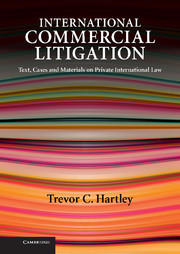Book contents
- Frontmatter
- Contents
- Table of panels
- List of figures
- Preface
- Acknowledgments
- Terminology
- Table of Latin phrases
- List of abbreviations
- Table of cases
- Table of cases (European Court of Justice, numerical order)
- Table of legislative instruments
- PART I STARTING OFF
- PART II JURISDICTION
- 2 Jurisdiction: an analysis
- 3 Jurisdiction under EC law
- 4 EC law: special jurisdiction
- 5 The traditional English rules
- 6 Developments in Canada
- 7 US law: an outline
- 8 Choice-of-court agreements
- 9 Forum non conveniens and antisuit injunctions
- 10 Overlapping jurisdiction in EC law
- 11 Special topics – I
- 12 Special topics – II
- PART III FOREIGN JUDGMENTS
- PART IV PROCEDURE
- PART V CHOICE OF LAW
- PART VI EXTRATERRITORIALITY
- Bibliography
- Index
9 - Forum non conveniens and antisuit injunctions
from PART II - JURISDICTION
- Frontmatter
- Contents
- Table of panels
- List of figures
- Preface
- Acknowledgments
- Terminology
- Table of Latin phrases
- List of abbreviations
- Table of cases
- Table of cases (European Court of Justice, numerical order)
- Table of legislative instruments
- PART I STARTING OFF
- PART II JURISDICTION
- 2 Jurisdiction: an analysis
- 3 Jurisdiction under EC law
- 4 EC law: special jurisdiction
- 5 The traditional English rules
- 6 Developments in Canada
- 7 US law: an outline
- 8 Choice-of-court agreements
- 9 Forum non conveniens and antisuit injunctions
- 10 Overlapping jurisdiction in EC law
- 11 Special topics – I
- 12 Special topics – II
- PART III FOREIGN JUDGMENTS
- PART IV PROCEDURE
- PART V CHOICE OF LAW
- PART VI EXTRATERRITORIALITY
- Bibliography
- Index
Summary
Introduction
The discussion so far has focused on the court before which proceedings have been brought. Now, we must broaden the scope of our investigation and look at the wider picture. It will be clear from what has been said that it can often happen that more than one court has jurisdiction in a case, something that can lead to potential or actual conflicts of jurisdiction. How are these resolved?
Here the common law and the civil law have radically different solutions. The civil law does nothing until there is an actual conflict, until the same case comes before two different courts. Then it applies the doctrine of lis pendens (more fully, lis alibi pendens). Under this, a court cannot hear proceedings if the same action is already pending before a court in another country. In other words, the court seised second must give the case up in favour of the court seised first. This approach has the advantage of simplicity. It is also fairly objective: though there is sometimes room for dispute as to exactly when a case is pending before a court, both courts will normally agree on which of them was seised first. Its disadvantage is that it makes no attempt to determine which court is more appropriate. Thus, a court that is ill placed to decide the case might get to hear it instead of one that is well placed.
- Type
- Chapter
- Information
- International Commercial LitigationText, Cases and Materials on Private International Law, pp. 205 - 236Publisher: Cambridge University PressPrint publication year: 2009



